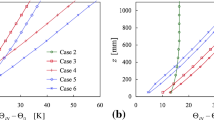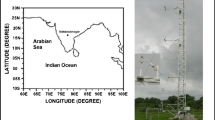Abstract
Influence of the surface roughness, geostrophic wind speed and initial stable stratification on surface layer scales, namely the friction velocity, temperature scale and the Monin-Obukhov length, and on non-dimensional profiles has been studied in quasi-stationary PIAPBLM (Prague Institute of Atmospheric Physics Boundary Layer Model) runs. Modifications of the stability functions, of the non-local mixing length concept, and of surface layer parametrization have improved the model results. With the ground temperature kept constant in time, the boundary layer is subjected to a turbulent cooling induced by surface roughness and to a counteracting turbulent heat transfer directed downwards. If the wind speed is lower, a rather mixed layer develops capped by a more stable layer. The estimated Monin-Obukhov length then slightly increases and the non-dimensional gradients overpredict the empirical values even more.
Similar content being viewed by others
References
Aloyan A.Ye., Yordanov D.L. and Penenko V.V., 1981: Parameterization of the surface layer with a variable height. Meteorology and Hydrology, 37-46 (in Russian).
André J.C., De Moor G., Lacarrère P., Therry G. and du Vachat R., 1978: Modeling the 24 h evolution of the mean and turbulent structures of the planetary boundary layer. J. Atmos. Sci., 35, 1861-1883.
Bougeault P., 1985: The diurnal cycle of the marine stratocumulus layer: A higher—order model study. J. Atmos. Sci., 42, 2826-2843.
Bougeault P. and André J.-C., 1986: On the stability of the third—order turbulence closure for the modeling of the stratocumulus—topped boundary layer. J. Atmos. Sci., 43, 1574-1581.
Bougeault P. and Lacarrère P., 1989: Parameterization of orography-induced turbulence in a mesobeta-scale model. Mon. Wea. Rev., 117, 1872-1890.
Byun D.W., 1990: On the analytical solution of flux-profile relationships for the atmospheric surface layer. J. Appl. Meteorol., 29, 652-657.
Delage Y., 1997: Parameterising sub-grid scale vertical transport in atmospheric models under statically stable conditions. Boundary-Layer Meteorol., 82, 23-48.
Enger L., Koračin D. and Yang X., 1993: A numerical study of boundary-layer dynamics in a mountain valley. Boundary-Layer Meteorol., 66, 357-394.
Garratt J.R., 1992: The Atmospheric Boundary Layer. Cambridge University Press, 316 pp.
Grandin G., 1983: A one-dimensional PBL model with a sub-grid scale condensation scheme for stratiform clouds and fog. Report No. 72, Department of Meteorology, University of Uppsala, Sweden.
Haltiner G.J. and Martin F.L., 1957: Dynamical and Physical Meteorology. McGraw-Hill, 470 pp.
Högström U., 1988: Non-dimensional wind and temperature profiles in the atmospheric surface layer: A re-evaluation. Boundary-Layer Meteorol., 42, 55-78.
Kalthoff N. and Vogel B., 1992: Counter-current and channelling effect under stable stratification in the area of Karlsruhe. Theor. Appl. Climatol., 45, 113-126.
Louis J.-F., 1979: A parametric model of vertical eddy fluxes in the atmosphere. Boundary-Layer Meteorol., 17, 187-202.
Pielke R.A., 1984: Mesoscale Meteorological Modeling. Academic Press, 612 pp.
Sedlák P., 1996: Influence of katabatic flow on the Greenland ice sheet melting: numerical experiments. In: I. Nemešová (Ed.), Climate Variability and Climate Change Vulnerability and Adaptation, Institute of Atmospheric Physics, Praha, 374-378.
Stull R.B., 1988: An Introduction to Boundary Layer Meteorology. Kluwer Academic Publishers, 666 pp.
Stull R.B., 1991: Static stability-an update. Bull. Amer. Meteor. Soc., 72, 1521-1529.
Svoboda J., 1975: Calculation methods for turbulent characteristics in the planetary boundary layer. Idöjárás, 79, 197-206.
Svoboda J., 1990: Numerical modeling of the atmospheric boundary layer over a hilly landscape. Studia geoph. et geod., 34, 167-184.
Svoboda J. and Štekl J., 1994: Mesoscale modelling of a flow modification caused by orography. Meteorol. Zeitschrift, N.F. 3, 233-241.
van den Hurk B.J.J.M. and Holtslag A.A.M., 1997: On the bulk parameterization of surface fluxes for various conditions and parameter ranges. Boundary-Layer Meteorol., 82, 119-134.
Author information
Authors and Affiliations
Rights and permissions
About this article
Cite this article
Sedlák, P. Stable Atmospheric Surface Layer in Modelling with Constant Ground Temperature. Studia Geophysica et Geodaetica 42, 41–60 (1998). https://doi.org/10.1023/A:1023316305631
Published:
Issue Date:
DOI: https://doi.org/10.1023/A:1023316305631




